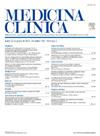IF 2.1
4区 医学
Q1 MEDICINE, GENERAL & INTERNAL
引用次数: 0
摘要
嗜酸性筋膜炎是一种罕见的硬皮病样综合征,原因不明。它的特点是疼痛的硬结和进行性增厚的肌肉筋膜和皮下组织的四肢和躯干。最常见的实验室表现包括外周嗜酸性粒细胞增多、高γ球蛋白血症和红细胞沉降率升高。通过对受影响的皮肤进行全层楔形活检,发现炎症和深筋膜增厚。鉴别诊断包括硬皮病、多发性硬皮病、移植物抗宿主病中的肌筋膜炎和毒素引起的流行性筋膜炎综合征,如嗜酸性粒细胞增多-肌痛综合征和中毒油综合征。虽然诊断是基于临床,实验室和组织学结果,没有普遍的诊断标准存在。糖皮质激素是标准的治疗方法,尽管有些患者可能会自发好转。本文章由计算机程序翻译,如有差异,请以英文原文为准。
Fascitis eosinofílica
Eosinophilic fasciitis is a rare scleroderma-like syndrome of unknown cause. It is characterized by painful induration and progressive thickening of the muscular fascia and subcutaneous tissue of the limbs and trunk. The most common laboratory findings include peripheral eosinophilia, hypergammaglobulinemia, and an elevated erythrocyte sedimentation rate. The diagnosis is confirmed through a full-thickness wedge biopsy of the affected skin, revealing inflammation and thickening of the deep fascia.
The differential diagnosis includes scleroderma, morphea, myofasciitis in graft-versus-host disease, and epidemic fasciitis syndromes caused by toxins, such as eosinophilia-myalgia syndrome and toxic oil syndrome. Although the diagnosis is based on clinical, laboratory, and histological findings, no universal diagnostic criteria exist. Glucocorticoids are the standard treatment, although some patients may improve spontaneously.
求助全文
通过发布文献求助,成功后即可免费获取论文全文。
去求助
来源期刊

Medicina Clinica
医学-医学:内科
CiteScore
3.10
自引率
5.10%
发文量
295
审稿时长
22 days
期刊介绍:
Medicina Clínica, fundada en 1943, es una publicación quincenal dedicada a la promoción de la investigación y de la práctica clínica entre los especialistas de la medicina interna, así como otras especialidades. Son características fundamentales de esta publicación el rigor científico y metodológico de sus artículos, la actualidad de los temas y, sobre todo, su sentido práctico, buscando siempre que la información sea de la mayor utilidad en la práctica clínica.
 求助内容:
求助内容: 应助结果提醒方式:
应助结果提醒方式:


